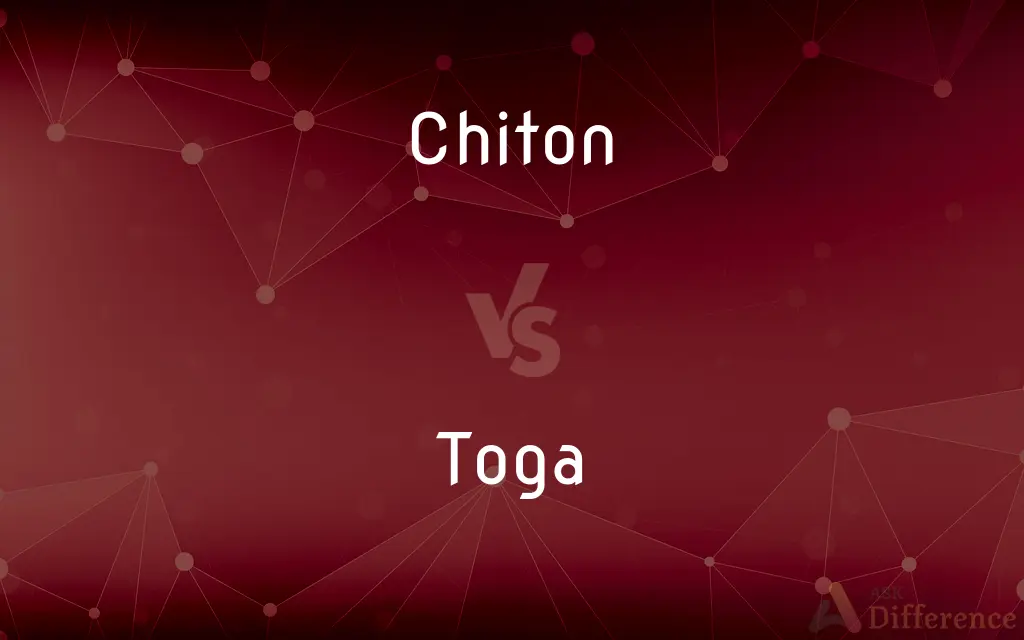Chiton vs. Toga — What's the Difference?
By Tayyaba Rehman & Urooj Arif — Updated on April 9, 2024
Chiton is an ancient Greek garment, while toga is a distinctive Roman cloak.

Difference Between Chiton and Toga
Table of Contents
ADVERTISEMENT
Key Differences
The chiton, rooted in ancient Greek culture, is a simple garment made of a rectangular piece of cloth, worn by both men and women, and secured at the shoulders with pins or brooches. In contrast, the toga is uniquely Roman, worn over a tunic, and symbolized Roman citizenship, showcasing the wearer's social status and affiliations.
While the chiton was often made from lighter fabrics and varied in length according to the wearer's gender and the fashion of the times, the toga was typically made from wool and was a heavier, more voluminous garment, indicating its significance in public life and ceremonial functions in ancient Rome.
The chiton allowed for easier movement, adapting to the Greek lifestyle that included athletic activities and labor. On the other hand, the toga, with its elaborate draping and specific way of wearing, was suited to the formal and political life of Rome, often restricting movement and requiring a slave's help to don correctly.
In terms of decoration and styling, chitons could be embellished with patterns, colors, and belts, reflecting personal taste and social status, while togas were generally white but varied in borders and length, indicating the wearer's age, rank, and office. The toga praetexta, for example, with its purple border, was worn by Roman magistrates and freeborn boys.
Both garments reflect the cultural values and social structures of their respective civilizations. The chiton's versatility and simplicity speak to a society that valued democracy, athleticism, and artistic expression, whereas the toga symbolized the power, hierarchy, and civic pride of Roman society.
ADVERTISEMENT
Comparison Chart
Origin
Ancient Greece
Ancient Rome
Material
Light fabrics like linen or wool
Usually heavy wool
Worn By
Both men and women
Primarily male citizens
Symbolism
Less symbolic, more functional
Signified citizenship and social status
Variations
Varied in length and could be belted
Distinguished by color and border for ranks
Movement
Allowed for easier movement
Restrictive and cumbersome
Cultural Value
Democracy, athleticism, arts
Power, hierarchy, civic pride
Compare with Definitions
Chiton
Made from rectangular pieces of cloth, it could be draped and pinned in various styles.
Her chiton was pinned at both shoulders and belted at the waist, creating elegant folds.
Toga
A distinctive garment of ancient Rome, draped over the body and worn over a tunic.
Senators in Rome distinguished themselves with a toga bordered in purple.
Chiton
A long garment worn by men and women in ancient Greece, fastened at the shoulders.
He wore a chiton that reached his ankles, a style popular in classical Athens.
Toga
Required skill to drape correctly and often needed assistance to wear.
Dressing in a toga required the help of a slave to arrange the folds properly.
Chiton
Often paired with a himation, a cloak, for additional coverage or warmth.
On cooler days, Greeks draped a himation over their chiton.
Toga
Symbolized Roman citizenship and was not worn by women or non-citizens.
The toga was a symbol of a man's status as a Roman citizen.
Chiton
Could be elaborately decorated for those of higher social status.
The chiton for the festival was dyed in bright colors and patterned with intricate designs.
Toga
Varied in form to indicate the wearer's status, from the plain toga virilis to the toga praetexta of magistrates.
Upon reaching adulthood, a Roman male donned the toga virilis as a sign of his citizenship.
Chiton
Adapted for athletic events, shorter chitons provided freedom of movement.
Athletes wore short chitons to compete in the Olympic Games.
Toga
Used in public appearances, speeches, and ceremonies, emphasizing its role in public life.
For his public speech, he wore a toga, signaling his authority and status.
Chiton
Chitons are marine molluscs of varying size in the class Polyplacophora , formerly known as Amphineura. About 940 extant and 430 fossil species are recognized.
Toga
The toga (, Classical Latin: [ˈt̪ɔ.ɡa]), a distinctive garment of ancient Rome, was a roughly semicircular cloth, between 12 and 20 feet (3.7 and 6.1 m) in length, draped over the shoulders and around the body. It was usually woven from white wool, and was worn over a tunic.
Chiton
A long woollen tunic worn in ancient Greece.
Toga
A loose flowing outer garment worn by the citizens of ancient Rome, made of a single piece of cloth and covering the whole body apart from the right arm.
Chiton
A marine mollusc that has an oval flattened body with a shell of overlapping plates.
Toga
A loose one-piece outer garment worn in public by male citizens in ancient Rome.
Chiton
Any of various marine mollusks of the class Polyplacophora that live on rocks and have shells consisting of eight overlapping calcareous plates. Also called sea cradle.
Toga
A robe of office; a professional or ceremonial gown.
Chiton
A tunic worn by men and women in ancient Greece.
Toga
A loose outer garment worn by the citizens of Ancient Rome.
Chiton
(historical) A loose woolen tunic worn by men and women in Ancient Greece.
Toga
A loose wrap gown.
Chiton
Any of various rock-clinging marine molluscs of the class Polyplacophora, including the genus Chiton.
Toga
(Philippines) An academic gown.
Chiton
An under garment among the ancient Greeks, nearly representing the modern shirt.
Toga
The loose outer garment worn by the ancient Romans, consisting of a single broad piece of woolen cloth of a shape approaching a semicircle. It was of undyed wool, except the border of the toga prætexta.
Chiton
One of a group of gastropod mollusks, with a shell composed of eight movable dorsal plates. See Polyplacophora.
Toga
A one-piece cloak worn by men in ancient Rome
Chiton
A woolen tunic worn by men and women in ancient Greece
Chiton
Primitive elongated bilaterally symmetrical marine mollusk having a mantle covered with eight calcareous plates
Common Curiosities
Why was the toga considered a symbol of Roman citizenship?
The toga was a distinctive Roman garment that only citizens were permitted to wear, symbolizing their legal and social standing.
Could a chiton be worn for formal occasions in ancient Greece?
Yes, chitons could be elaborately decorated and styled for formal events and religious ceremonies.
Was the toga worn in daily life by Romans?
By the late Republic and Empire, the toga was primarily worn for formal occasions, due to its cumbersome nature.
How did the styles of chitons change over time?
Styles varied with fashion, including changes in length, the addition of sleeves, and how it was fastened or belted.
Were chitons and togas worn in the same period?
Both garments were worn in their respective cultures during overlapping time periods, but the chiton predates the toga.
Did women wear togas in ancient Rome?
No, women wore a garment called a stola, while the toga was reserved for male citizens.
How did one distinguish between different types of togas?
Differences were marked by color, border, and the manner of draping, each indicating the wearer's age, social rank, or office.
Could slaves or foreigners wear togas in Rome?
Slaves and foreigners were not permitted to wear togas, as the garment was a symbol of Roman citizenship.
Did the material of the chiton vary by status?
Yes, higher-quality materials and decorations were used for those of higher social status.
Is there any similarity between a chiton and any Roman garment?
The Roman tunic worn under the toga shares similarities with the chiton, as a basic garment, but the toga itself is unique.
Share Your Discovery

Previous Comparison
Periodic vs. Periodical
Next Comparison
Granny vs. GrandmotherAuthor Spotlight
Written by
Tayyaba RehmanTayyaba Rehman is a distinguished writer, currently serving as a primary contributor to askdifference.com. As a researcher in semantics and etymology, Tayyaba's passion for the complexity of languages and their distinctions has found a perfect home on the platform. Tayyaba delves into the intricacies of language, distinguishing between commonly confused words and phrases, thereby providing clarity for readers worldwide.
Co-written by
Urooj ArifUrooj is a skilled content writer at Ask Difference, known for her exceptional ability to simplify complex topics into engaging and informative content. With a passion for research and a flair for clear, concise writing, she consistently delivers articles that resonate with our diverse audience.














































